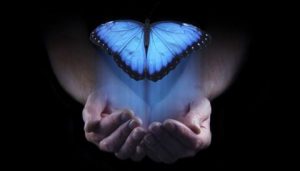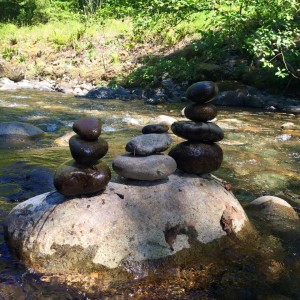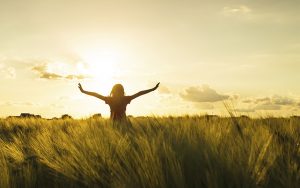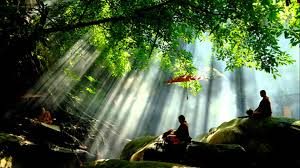 The Yogabliss, Your Heart Life on-line Moving into Meditation classes met this morning. We explored Earth qualities of Stability, Patience and Inclusiveness. We contemplated the meaning of refuge in our lives. We considered practical ways we find balance and ease in our daily lives. Looking more deeply, we explored what inner and outer resources enable us to live with awareness and loving kindness.
The Yogabliss, Your Heart Life on-line Moving into Meditation classes met this morning. We explored Earth qualities of Stability, Patience and Inclusiveness. We contemplated the meaning of refuge in our lives. We considered practical ways we find balance and ease in our daily lives. Looking more deeply, we explored what inner and outer resources enable us to live with awareness and loving kindness.
We drew inspiration from the spiritual teachings of Thich Nhat Hanh including his Ten Love Letters to the Earth. We heard the poem, Earth Touching, from his book Please Call Me By My True Names. You can find some beautiful Earth Touching Practices on the Plum Village web-site. We also heard Thay’s teaching one the spiritual meaning of Taking Refuge.
We drew from meditation instructor Beth Roth’s Tricycle Magazine article: Family Dharma: Taking Refuge (On the Wings of Angels). This article includes a very personal and tender account of Beth’s family experience of refuge.
We heard Mary Oliver’s poem: Mysteries, Yes. Mary Oliver is a poet whose life and work seem to affirm and explore the importance of a living a conscious life. Her poems encourage us to cultivate a sense of connectedness, devotion, gratitude and wonder. She lived her life taking refuge in Mother Earth.
I invite you to explore your experience of embodiment. Notice the places that are touching Earth and feel those connections – the bottoms of your feet; the back of legs and thighs; the two sit bones, the back of your head and spine if you are lying down. You can sense Earth in your bones – the bowl of your pelvis; the length of your spine; the round orb of your skull. How do you experience Earth supporting you – from outside and inside? What is your experience of stability?
You might notice areas of fluidity, movement and change. You can explore feeling breathing. Notice areas that are subtly moving – across your chest; between your ribs; your belly. If the breath isn’t easy can you can change focus to other sensation or sound. Allow the time you need to take good care of yourself. Can you be patient with what doesn’t come easily?
You may be aware of the state of mind. Is it calm and quiet? Busy? Planning? Remembering? How does it distance you from this present moment? Can there be recognition of where you are without judgment? You can explore moving awareness to feeling breathing or sensation and allow mind to be present too.
If aware of emotion, how are you meeting feeling experience? Can this, too, be welcome? You can explore the qualities of stability, patience and inclusivity or other inner resources that enable you to be in this present moment. You can begin again and again by experiencing Body as Body; your Body in relation to Earth’s Body. You can be aware of Earth’s constant presence as the ground upon which you rest. In one of his Ten Letters to Mother Earth, Thich Nhat Hanh wrote:
You are this infinitely beautiful blue planet, fragrant, cool, and kind. Your immeasurable patience and endurance makes you a great bodhisattva. . . . Whenever I am unstable, every time I lose touch with myself, or am lost in forgetfulness, sadness, hatred, or despair, I know I can come back to you. Touching you, I can find a refuge; I can reestablish my peace and regain my joy and self-confidence. You love, protect, and nurture all of us without discrimination. . . . You have an extraordinary capacity to renew, transform, and heal yourself—and also us, your children. . . I can take refuge in you. As I walk, sit, and breathe, I can surrender myself to you, trust wholly in you, and allow you to heal me.
You can take a few moments to reflect on how you relate to our Earth. What is your experience of refuge? How do you reestablish peace? Thay writes:
 Each one of us needs a place of refuge, but we may not know how to find it or how to get there. Looking deeply today, I can see that my true home, my true place of refuge is you, my beloved planet. I take refuge in you, Mother Earth. I do not have to go anywhere to find you; you are already in me and I am already in you.
Each one of us needs a place of refuge, but we may not know how to find it or how to get there. Looking deeply today, I can see that my true home, my true place of refuge is you, my beloved planet. I take refuge in you, Mother Earth. I do not have to go anywhere to find you; you are already in me and I am already in you.
We can give ourselves over to experiencing Body as Body; feeling our Body on Earth’s Body. What does Earth have to teach us? What possibilities lie in her deep ground of stillness? What truths might we discover living in our own hearts? Right now you can touch Earth hearing Thay’s poem:
Earth Touching
Here is the foot of a tree.
Here is an empty, quiet place.
Here is a cushion.
Brother, why don’t you sit down?
 Sit upright.
Sit upright.
Sit with solidity.
Sit in peace.
Don’t let your thoughts lift you up into the air.
Sit so that you can really touch the Earth and be one with her.
You may like to smile, brother.
Earth will transmit to you her solidity, her peace, and her joy.
With your mindful breathing, with your peaceful smile,
you sustain the mudra of Earth Touching.
When we rest on Earth’s Body, we can imagine ourselves nestling down onto her outermost skin – the Soil. Her Soil supports us. Her Soil sustains us. We are fortunate beyond measure to lay our bodies down on Earth’s Body. We can be held while we dream, listen, grieve and at times feel peace. We can take refuge.
What does it mean to “take refuge?” In her exploration of Taking Refuge, as a spiritual practice, meditation instructor Beth Roth writes:
Every one of us is already taking refuge in our lives. We seek refuge when we want to feel more ok, when we need relief from the discomfort of feeling not ok, or when we require a distraction from our problems and difficulties. Some of these refuges are skillful because they contain the possibility of healing, such as communion with nature, spiritual practices, support of family and friends, and pursuit of art, music, literature, poetry, sports, or movement.
Some refuges are not so skillful, because while they may provide a temporary escape from our pain, they do not increase our insight about our predicament. For example, denial of our suffering, or avoidance of pain through substance abuse, workaholism, obsessive shopping, or incessant busyness are unlikely to promote the wisdom and self-compassion necessary for healing.
So much of life is challenging. It can be difficult to find balance, ease or even hope for the future. We can reflect on those places we find refuge, safety and solace. What or who can you entrust yourself to?
In the Buddhist tradition, Beth explains:
 . . . Taking Refuge means to cultivate an unshakable sense of safety, protection, and belonging. Taking Refuge provides a context for our spiritual journey. We take three refuges, which are often called The Three Jewels or The Triple Gem: the Buddha, the Dharma, and the Sangha.
. . . Taking Refuge means to cultivate an unshakable sense of safety, protection, and belonging. Taking Refuge provides a context for our spiritual journey. We take three refuges, which are often called The Three Jewels or The Triple Gem: the Buddha, the Dharma, and the Sangha.
In referring to the Buddha we can consider how we can take refuge in a human being:
. . . someone who embodies boundless wisdom and compassion, in whose light and presence we feel held and loved. . . . As Thich Nhat Hanh interprets this refuge for the Western practitioner, “I take refuge in the Buddha, the one who shows me the way in this life.”
You can take a moment to reflect on someone who has offered you wisdom and compassion – perhaps in the form of counsel, teaching, safety, support. How did you experience their presence?
The Dharma generally refers to the Buddha’s teachings. These teachings include the ethical precepts of ‘non-harming, protecting nature, practicing loving kindness and meditation. Beth explains:
 To take refuge in the Dharma means to trust in our ability to engage mindfully with the entirety of our life. . . embark[ing] on the path that leads to the end of suffering. Thich Nhat Hanh says, “I take refuge in the Dharma the way of understanding and love.”
To take refuge in the Dharma means to trust in our ability to engage mindfully with the entirety of our life. . . embark[ing] on the path that leads to the end of suffering. Thich Nhat Hanh says, “I take refuge in the Dharma the way of understanding and love.”
You can consider the wisdom teachings of your particular faith or spiritual tradition. How do they help you to live in the light of understanding and love?
Sangha is a Pali or Sanskrit word for community. When we recognize we are in good company, we recognize we are not alone.
Our Sangha may be our family, our friends, our meditation group, our religious community, . . . our favorite place in nature. Thich Nhat Hanh says, “I take refuge in the Sangha, the community that lives in harmony and awareness.” He further explains, “When a community sits, breathes, walks and eats together in mindfulness, holiness is there… Because the problems facing the world are so great today, … Sangha- building is the most important work we can do.”
 What is your experience of community? Where do you find kinship? What is it like to know that you are part of something larger perhaps even mysterious and wonderful?
What is your experience of community? Where do you find kinship? What is it like to know that you are part of something larger perhaps even mysterious and wonderful?
Intentionally taking refuge is the practice of living a conscious life in which we consider how we walk on Mother Earth. Mary Oliver is a poet whose life and work seem to affirm and explore the importance of a living a conscious life. Her poems encourage us to cultivate a sense of connectedness, devotion, gratitude and wonder. She lived her life taking refuge in Mother Earth. This one is called Mysteries, Yes.
Truly, we live with mysteries too marvelous
to be understood.
How grass can be nourishing in the
mouths of the lambs.
 How rivers and stones are forever
How rivers and stones are forever
while we ourselves dream of rising.
How two hands touch and the bonds will
never be broken.
How people come, from delight or the
scars of damage,
to the comfort of a poem.
Let me keep my distance, always, from those
who think they have the answers.
Let me keep company always with those who say
“Look!” and laugh in astonishment,
and bow their heads.
Here we “come, from delight or the scars of damage, to the comfort of a poem . . “ to the comfort of Earth. Let us keep company always in the practice of loving kindness.


